Table of Contents
- Introduction
- Editor’s Choice
- Home & Laundry Care Industry Statistics
- Revenue Generation Through Home & Laundry Care Services Industry Statistics
- Global Home Improvement Services Industry Statistics
- Global Home Decor Industry Statistics
- Smart Homes Statistics
- Home Care Brands Statistics
- Home Care Services and Solutions and Services Statistics
- Demographic Distribution of Home Care Workers
- Home Care Industry Spending Statistics
- Challenges and Concerns
- Regulations, Legislations, and Laws for the Home Care Industry Statistics
- Recent Developments
- Conclusion
- FAQs
Introduction
Home Care Industry Statistics: The home care industry provides essential support for individuals who need assistance. With daily activities, particularly for the elderly, disabled, and those with chronic conditions.
It encompasses personal care services, home health care, and respite care, with a focus on delivering support in a home setting.
Driven by an aging population, increasing prevalence of chronic diseases, and a preference for home-based care. The industry faces challenges such as workforce shortages and regulatory compliance.
Technological advancements like telemedicine and home monitoring systems are shaping the sector, which is expected to grow steadily.
Funding comes from private pay, insurance, and government programs, reflecting the industry’s crucial role in the healthcare system.
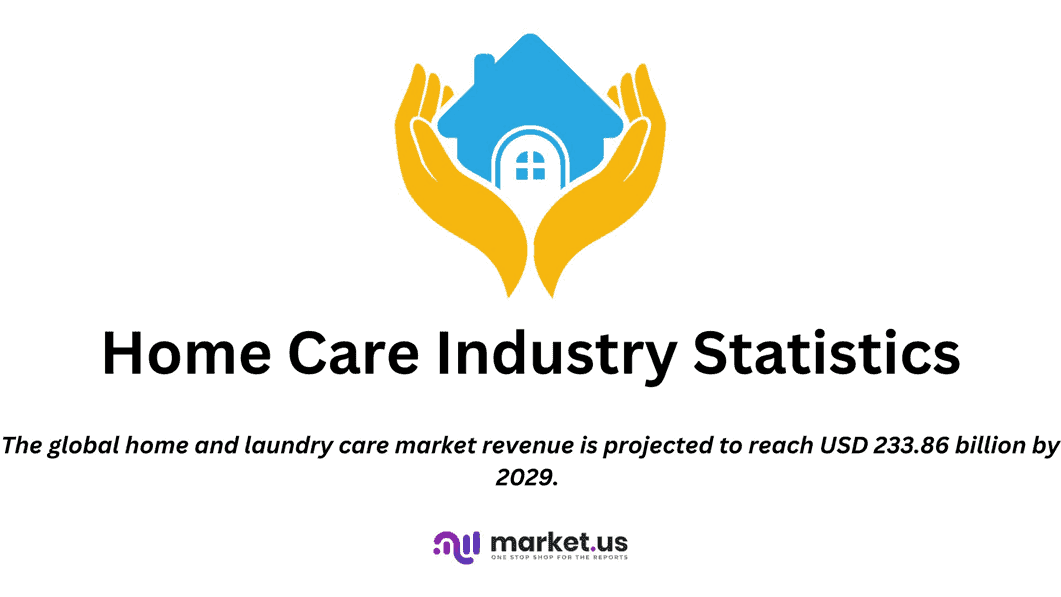
Editor’s Choice
- The Home Healthcare Market size is expected to be worth around USD 797.8 billion by 2032 from USD 369.3 billion in 2022, growing at a CAGR of 8.2%
- The global home and laundry care market revenue is projected to reach USD 233.86 billion by 2029.
- Several key factors drive the revenue changes in the global home and laundry care market. The primary driver is the increase in disposable income, contributing 4.2% to the market growth.
- The global home improvement services market is projected to reach USD 652.3 billion by 2033.
- The global home decor market is projected to be USD 949.0 billion by 2033.
- By 2028, the number of smart home users worldwide is expected to reach an impressive 785.16 million.
- By 2022, home healthcare expenditure had grown to USD 132.9 billion in the U.S.
- In 2017, various concerns influenced the adoption of smart home devices worldwide. As reflected by the share of respondents expressing different levels of concern. High prices were a significant worry, with 44% of respondents being very concerned, 33% somewhat concerned, 17% slightly concerned, and 5% not at all concerned.
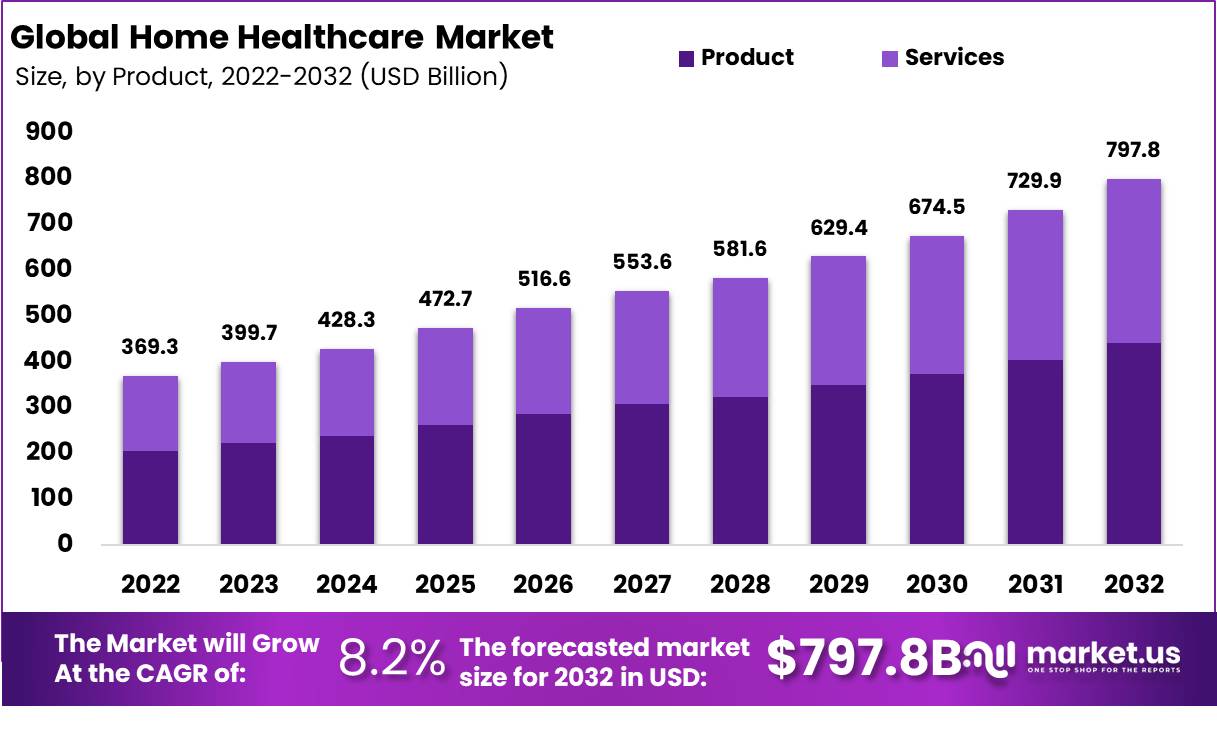
Home & Laundry Care Industry Statistics
Global Home & Laundry Care Industry Size Statistics
- The global home and laundry care market has demonstrated a consistent growth trajectory over the past decade at a CAGR of 3.18%.
- In 2018, the market was valued at USD 160.54 billion, increasing to USD 163.20 billion in 2019.
- A notable rise was observed in 2020, reaching USD 172.28 billion. Likely influenced by heightened hygiene awareness due to the COVID-19 pandemic.
- This upward trend continued in 2021, with the market value climbing to USD 185.01 billion.
- However, a slight dip occurred in 2022, bringing the market value to USD 181.02 billion.
- Despite this minor setback, the market rebounded strongly in 2023, achieving a value of USD 192.96 billion.
- Projections indicate sustained growth, with the market expected to reach USD 199.94 billion in 2024, USD 206.80 billion in 2025, and USD 213.65 billion in 2026.
- Further forecasts suggest the market will continue to expand. Reaching USD 220.36 billion in 2027, USD 227.36 billion in 2028, and USD 233.86 billion by 2029.
(Source: Statista)

Global Home & Laundry Care Industry Size – By Type Statistics
2018-2023
- The global home and laundry care market is segmented by type. It has experienced steady growth across various product categories from 2018 to 2023.
- In 2018, the market value for dishwashing detergents was USD 22.13 billion, household cleaners USD 31.58 billion, laundry care USD 85.64 billion, and polishes, room scents, and insecticides USD 21.19 billion.
- By 2019, these values had risen to USD 22.43 billion, USD 32.14 billion, USD 87.11 billion, and USD 21.52 billion, respectively.
- The upward trend continued in 2020, with dishwashing detergents reaching USD 24.11 billion, household cleaners USD 34.75 billion, laundry care USD 91.01 billion, and polishes, room scents, and insecticides USD 22.41 billion.
- In 2021, further increases were observed, with dishwashing detergents at USD 26.19 billion, and household cleaners at USD 38.04 billion. Laundry care at USD 96.93 billion, and polishes, room scents, and insecticides at USD 23.85 billion.
- Although 2022 saw a slight dip in some categories, dishwashing detergents stood at USD 24.8 billion, household cleaners at USD 35.45 billion, laundry care at USD 97.3 billion, and polishes, room scents, and insecticides at USD 23.47 billion.
- The market rebounded in 2023 with dishwashing detergents at USD 26.64 billion, household cleaners at USD 38.39 billion, laundry care at USD 102.8 billion, and polishes, room scents, and insecticides at USD 25.13 billion.
2024-2029
- Projections for the future indicate continued growth across all categories. By 2024, dishwashing detergents are expected to reach USD 27.66 billion, household cleaners USD 39.79 billion. Laundry care is USD 106.4 billion, and polishes, room scents, and insecticides are USD 26.09 billion.
- The trend is set to continue, with dishwashing detergents reaching USD 28.62 billion, and household cleaners USD 41.15 billion. Laundry care USD 110 billion, and polishes, room scents, and insecticides USD 27.03 billion in 2025.
- By 2026, these values are projected to be USD 29.58 billion. USD 42.5 billion, USD 113.6 billion, and USD 27.97 billion, respectively.
- Further projections for 2027 show dishwashing detergents at USD 30.51 billion, household cleaners at USD 43.85 billion, laundry care at USD 117.1 billion, and polishes, room scents, and insecticides at USD 28.9 billion.
- In 2028, dishwashing detergents are expected to reach USD 31.49 billion, household cleaners USD 45.21 billion. Laundry care is USD 120.8 billion, and polishes, room scents, and insecticides are USD 29.86 billion.
- By 2029, the market values are anticipated to be USD 32.41 billion for dishwashing detergents, USD 46.5 billion for household cleaners, USD 124.2 billion for laundry care, and USD 30.75 billion for polishes, room scents, and insecticides.
(Source: Statista)
Take advantage of our unbeatable offer - buy now!

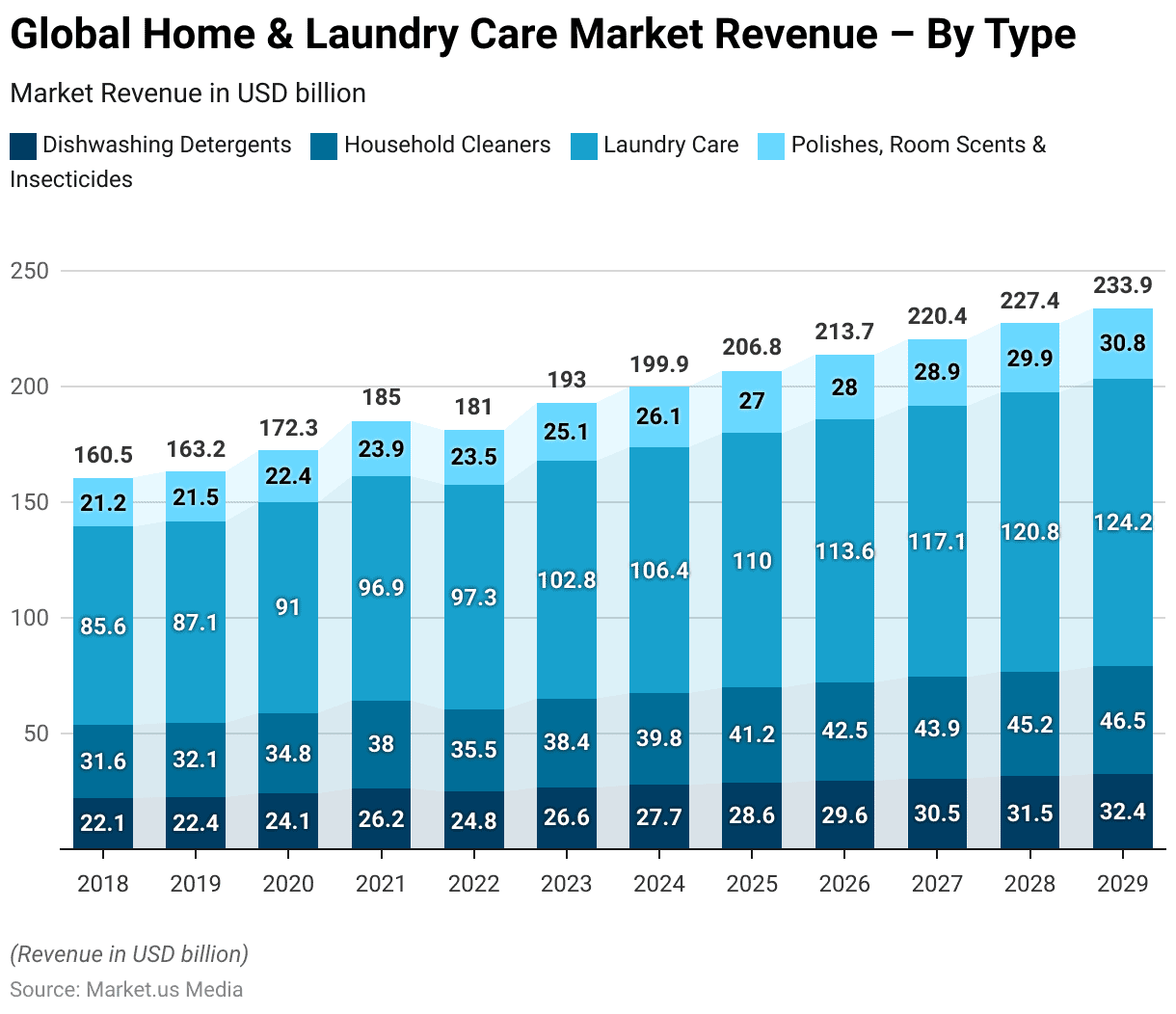
Global Home & Laundry Care Industry Revenue Change – By Type Statistics
2019-2023
- The global home and laundry care market has experienced varied revenue changes across different product categories from 2019 to 2029.
- In 2019, dishwashing detergents saw a revenue change of 1.4%, household cleaners 1.8%, laundry care 1.7%, and polishes, room scents, and insecticides 1.6%.
- The year 2020 marked significant growth, with dishwashing detergents increasing by 7.5%, household cleaners by 8.1%, laundry care by 4.5%, and polishes, room scents, and insecticides by 4.1%.
- This positive trend continued in 2021 with further increases: dishwashing detergents rose by 8.7%, household cleaners by 9.5%, laundry care by 6.5%, and polishes, room scents, and insecticides by 6.4%.
- However, 2022 saw a downturn, with dishwashing detergents experiencing a revenue change of –5.3%, and household cleaners -by 6.8%. Laundry care showed a marginal increase of 0.4%, and polishes, room scents, and insecticides decreased by -1.6%.
- The market recovered in 2023, with dishwashing detergents growing by 7.4%, household cleaners by 8.3%, laundry care by 5.7%, and polishes, room scents, and insecticides by 7.1%.
2024-2029
- From 2024 onwards, the market growth stabilized with moderate increases. In 2024, dishwashing detergents grew by 3.8%, household cleaners by 3.7%, laundry care by 3.5%, and polishes, room scents, and insecticides by 3.8%.
- This trend of modest growth continued through 2025 and 2026, with dishwashing detergents increasing by 3.5% and 3.3%, household cleaners by 3.4% and 3.3%, laundry care by 3.4% and 3.2%, and polishes, room scents, and insecticides by 3.6% and 3.5%, respectively.
- In the subsequent years, 2027 and 2028, dishwashing detergents grew by 3.2% each year, household cleaners by 3.2% and 3.1%, laundry care by 3.1% each year, and polishes, room scents, and insecticides by 3.3% each year.
- By 2029, the revenue growth rates were slightly lower, with dishwashing detergents increasing by 2.9%. Household cleaners by 2.8%, laundry care by 2.8%, and polishes, room scents, and insecticides by 3.0%.
(Source: Statista)

Market Drivers for Revenue Change
- Several key factors drive the revenue changes in the global home and laundry care market. The primary driver is the increase in disposable income, contributing 4.2% to the market growth.
- This is followed by GDP growth, which adds another 3.0%.
- The impact of inflation has a smaller yet significant effect, accounting for 1.3% of the revenue change.
- Growth in the global industrial packaging market also plays a role, contributing 0.9%.
- However, health and environmental issues related to chemicals negatively impact the market, reducing growth by 2.8%.
- Overall, these factors combine to result in a total market growth of 6.6%.
(Source: Statista)
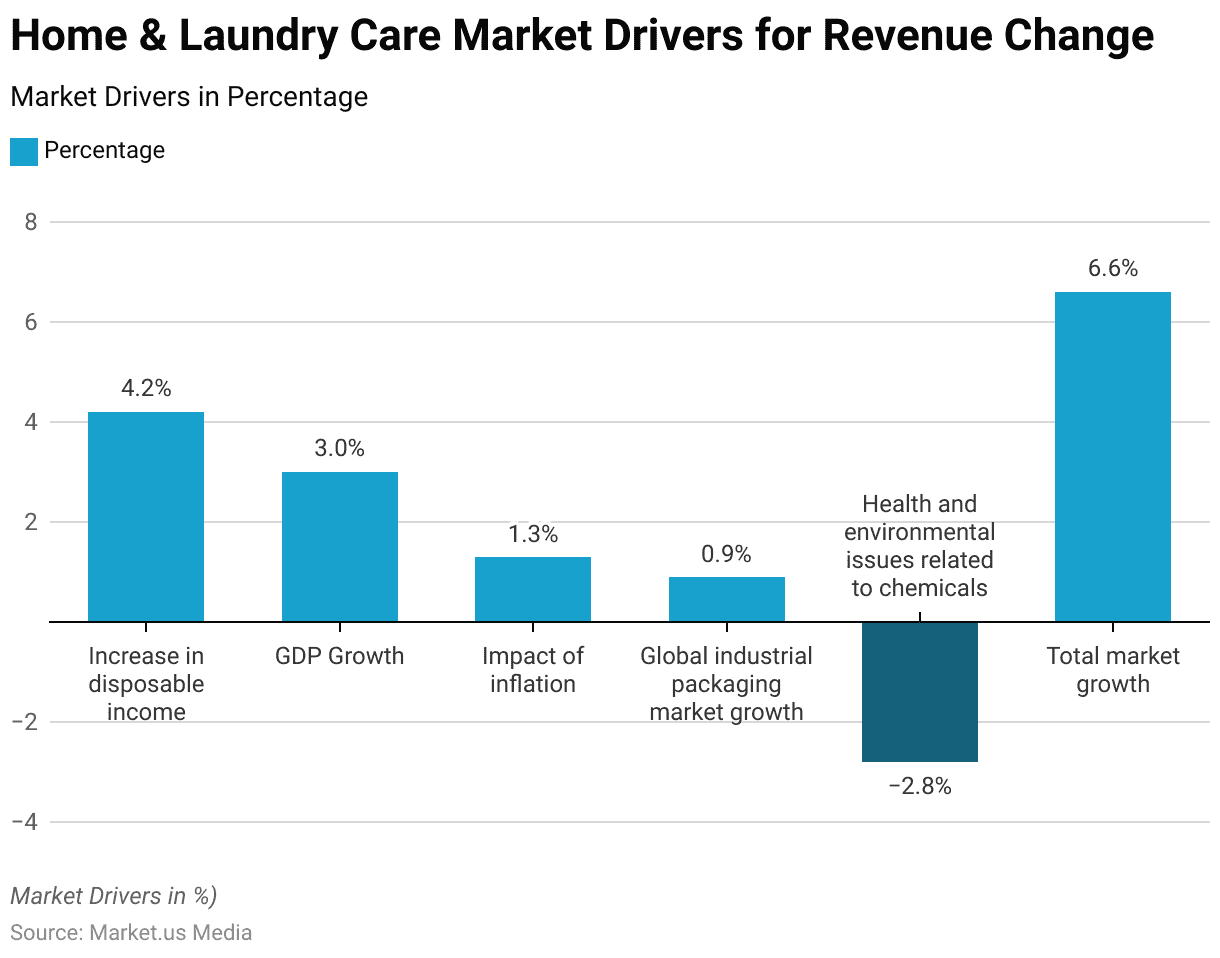
Global Home & Laundry Care Industry Share – By Sales Channel Statistics
- The global home and laundry care market has seen a significant shift in market share by sales channel from 2018 to 2027.
- In 2018, offline sales dominated the market with a share of 96.3%. While online sales accounted for only 3.7%.
- This trend continued in 2019, with offline sales at 95.7% and online sales at 4.3%.
- The year 2020 marked a notable increase in online sales, which rose to 5.3%. While offline sales decreased to 94.7%.
- This shift persisted through 2021, with online sales growing to 6.1% and offline sales declining to 93.9%.
- By 2022, the trend continued, with online sales reaching 7.0% and offline sales dropping to 93.0%. In 2023, online sales further increased to 7.5%, and offline sales reduced to 92.5%.
- The forecast for 2024 shows online sales climbing to 8.9%, with offline sales decreasing to 91.1%.
- The shift becomes more pronounced in 2025, with online sales projected to reach 10.5% and offline sales falling to 89.5%.
- This trend is expected to persist in 2026, with online sales at 10.9% and offline sales at 89.1%. And by 2027, online sales are anticipated to grow to 11.5%. While offline sales will further decline to 88.5%.
- This data highlights the ongoing and increasing consumer preference for online purchasing within the home and laundry care market.
(Source: Statista)

Competitive Landscape of Global Home & Laundry Care Industry Statistics
- In 2022, the global home and laundry care market was characterized by a diverse range of brands, with a few key players capturing a modest share.
- Febreze and Persil each held a market share of 3%, reflecting their strong presence and consumer preference within the industry.
- Bonux, Downy, and Tide each accounted for 2% of the market. Indicating their significant but slightly lesser influence compared to the leading brands.
- The remaining 88% of the market was comprised of various other brands. Highlighting the extensive variety and competition within the home and laundry care sector.
- This distribution underscores the fragmented nature of the market, with many brands vying for consumer attention and market share.
(Source: Statista)
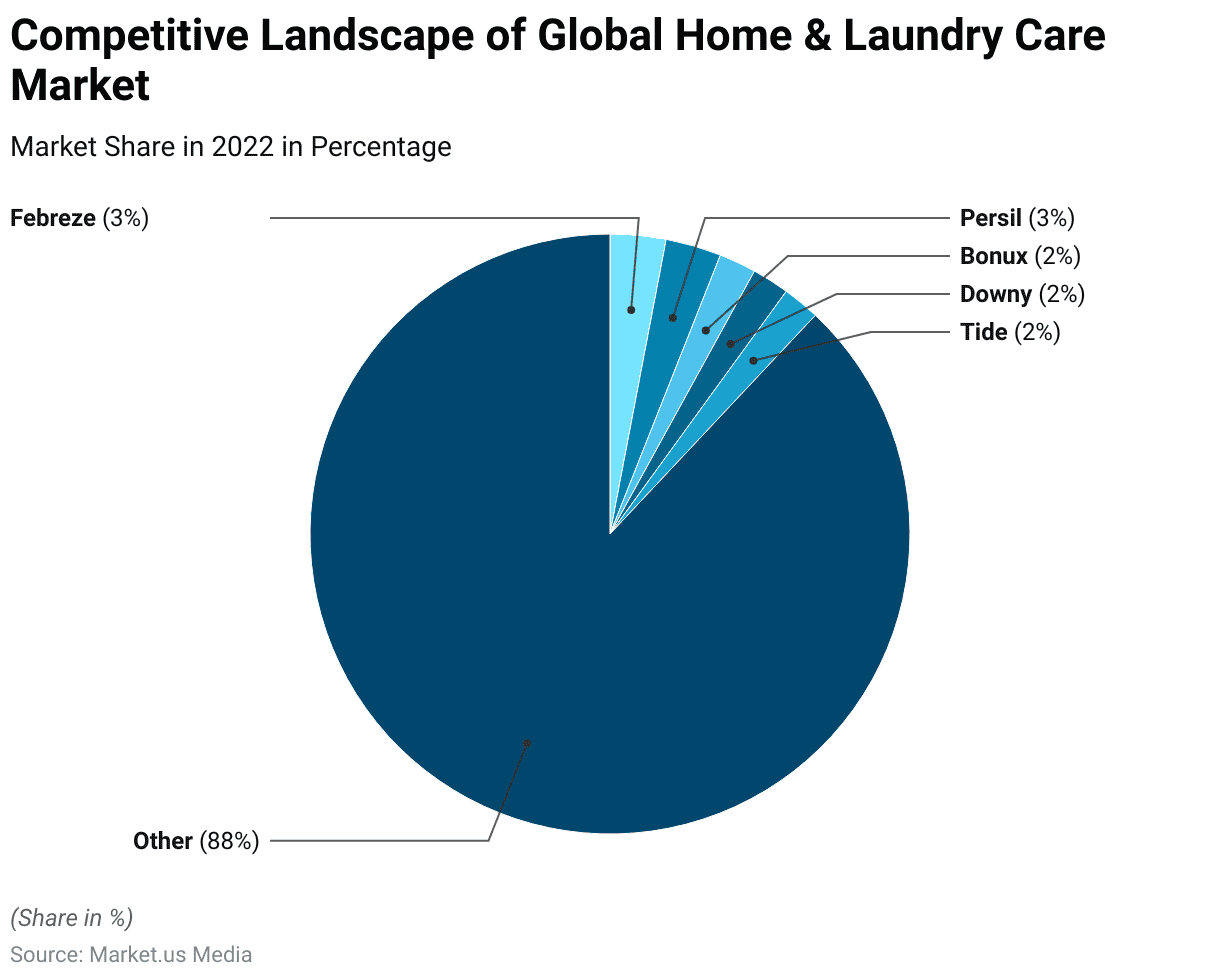
Home & Laundry Care Industry Revenue – By Country Statistics
- In 2022, the global home and laundry care market exhibited significant revenue contributions from various countries, reflecting their market sizes and consumer demand.
- The United States led the market with a substantial revenue of USD 32,170 million, followed by China with USD 20,640 million.
- India secured the third position with a revenue of USD 8,227 million. Closely followed by Japan at USD 7,858 million and Indonesia at USD 7,029 million.
- European countries also showed a strong market presence. Germany generated USD 6,353 million, France USD 5,659 million, and the United Kingdom USD 5,953 million.
- Brazil and Mexico represented the Latin American market, contributing USD 5,954 million and USD 4,908 million, respectively.
- Italy, another significant player, recorded a revenue of USD 4,813 million.
- In Southeast Asia, Thailand and Vietnam contributed USD 3,572 million and USD 2,797 million, respectively, while the Philippines added USD 3,319 million.
- Canada’s market stood at USD 3,443 million, and Russia’s at USD 3,427 million.
- South Korea also marked its presence with a revenue of USD 3,284 million.
- This data underscores the diverse and widespread nature of the home and laundry care market across different regions and economies.
(Source: Statista)

Revenue Generation Through Home & Laundry Care Services Industry Statistics
2018-2022
- The average revenue per capita in the global home and laundry care market has shown a steady increase from 2018 to 2022 across various product categories.
- In 2018, the revenue per capita for dishwashing detergents was USD 3.01. Household cleaners are USD 4.29, laundry care is USD 11.63, and polishes, room scents, and insecticides are USD 2.88.
- This trend of growth continued in 2019 with dishwashing detergents at USD 3.02, household cleaners at USD 4.32, laundry care at USD 11.71, and polishes, room scents, and insecticides at USD 2.90.
- By 2020, the revenue per capita increased further. With dishwashing detergents at USD 3.21, household cleaners at USD 4.63, laundry care at USD 12.13, and polishes, room scents, and insecticides at USD 2.99.
- In 2021, the figures rose to USD 3.46 for dishwashing detergents, USD 5.03 for household cleaners, USD 12.81 for laundry care, and USD 3.15 for polishes, room scents, and insecticides.
- In 2022, there was a slight dip in some categories. With dishwashing detergents at USD 3.25 and household cleaners at USD 4.65. While laundry care and polishes, room scents, and insecticides maintained their growth at USD 12.76 and USD 3.08, respectively.
2023-2029
- The market rebounded in 2023, with dishwashing detergents at USD 3.47, household cleaners at USD 5.00, laundry care at USD 13.38, and polishes, room scents, and insecticides at USD 3.27.
- Projections indicate continued growth, with dishwashing detergents expected to reach USD 3.57 in 2024, household cleaners USD 5.14, laundry care USD 13.74, and polishes, room scents, and insecticides USD 3.37.
- This upward trend is set to persist, with 2025 estimates at USD 3.66 for dishwashing detergents, USD 5.27 for household cleaners, USD 14.08 for laundry care, and USD 3.46 for polishes, room scents, and insecticides.
- By 2026, the average revenue per capita is projected to be USD 3.76 for dishwashing detergents, USD 5.40 for household cleaners, USD 14.42 for laundry care, and USD 3.55 for polishes, room scents, and insecticides.
- The growth continues into 2027 with USD 3.84, USD 5.52, USD 14.76, and USD 3.64, respectively, and in 2028 with USD 3.94, USD 5.65, USD 15.10, and USD 3.73, respectively.
- By 2029, the average revenue per capita is expected to reach USD 4.02 for dishwashing detergents, USD 5.77 for household cleaners, USD 15.41 for laundry care, and USD 3.82 for polishes, room scents, and insecticides, reflecting a consistent and gradual increase over the years.
(Source: Statista)
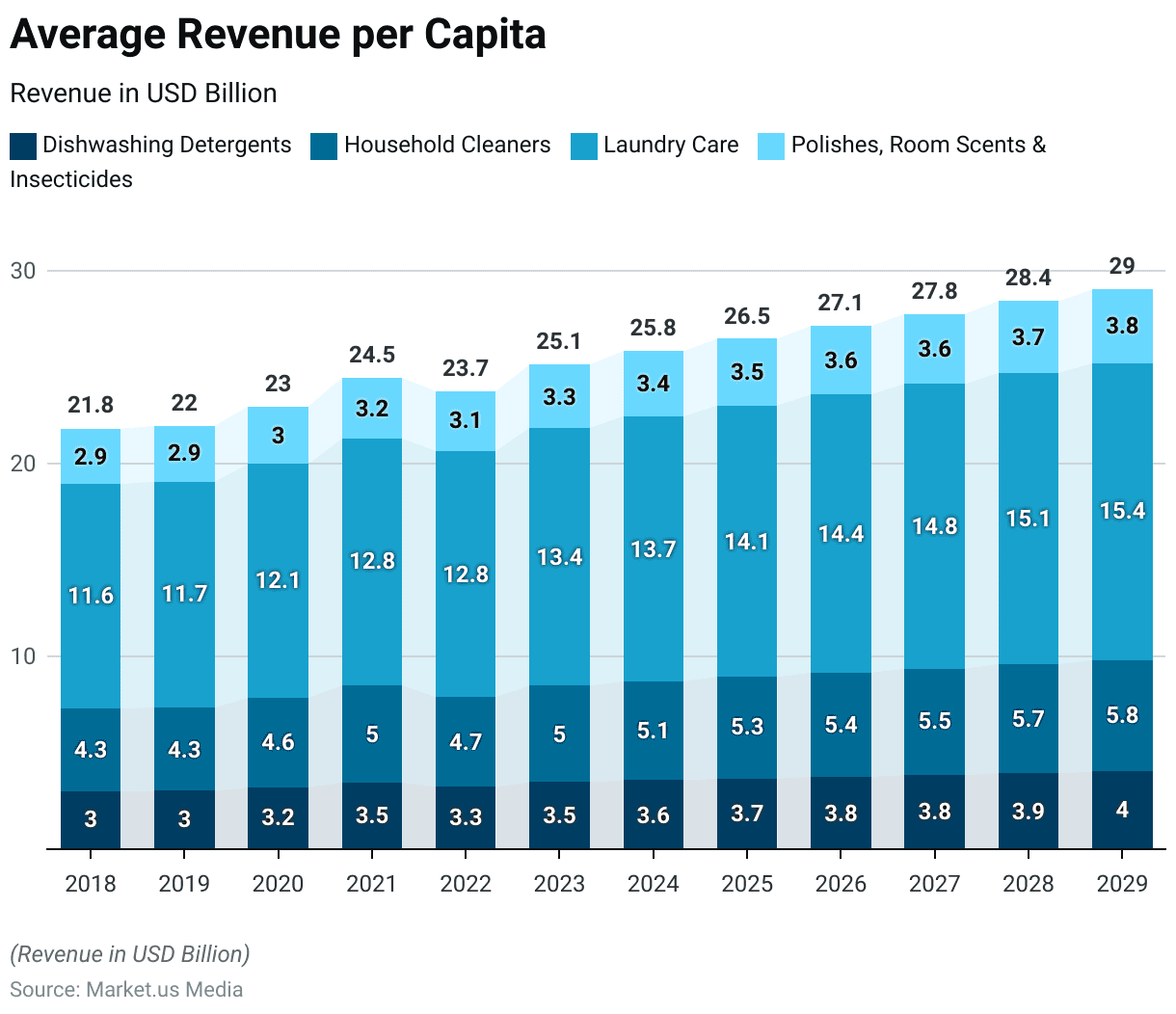
Global Home Improvement Services Industry Statistics
Global Home Improvement Services Industry Size Statistics
- The global home improvement services market is projected to witness substantial growth from 2023 to 2033 at a CAGR of 5.50%.
- In 2023, the market value is expected to be USD 381.9 billion.
- This positive trend is set to continue, with the market anticipated to reach USD 402.9 billion in 2024 and USD 421.1 billion in 2025.
- The growth trajectory remains strong, with the market projected to rise to USD 448.4 billion by 2026 and USD 473.1 billion by 2027.
- By 2028, the market value is forecasted to be USD 499.1 billion. Further increasing to USD 526.6 billion in 2029.
- In 2030, the market is expected to reach USD 555.5 billion, reflecting sustained expansion.
- This upward trend is predicted to continue, with the market value reaching USD 586.1 billion in 2031, USD 618.3 billion in 2032, and an impressive USD 652.3 billion by 2033.
- This data underscores the robust and continuous growth of the global home improvement services market over the next decade.
(Source: market.us)
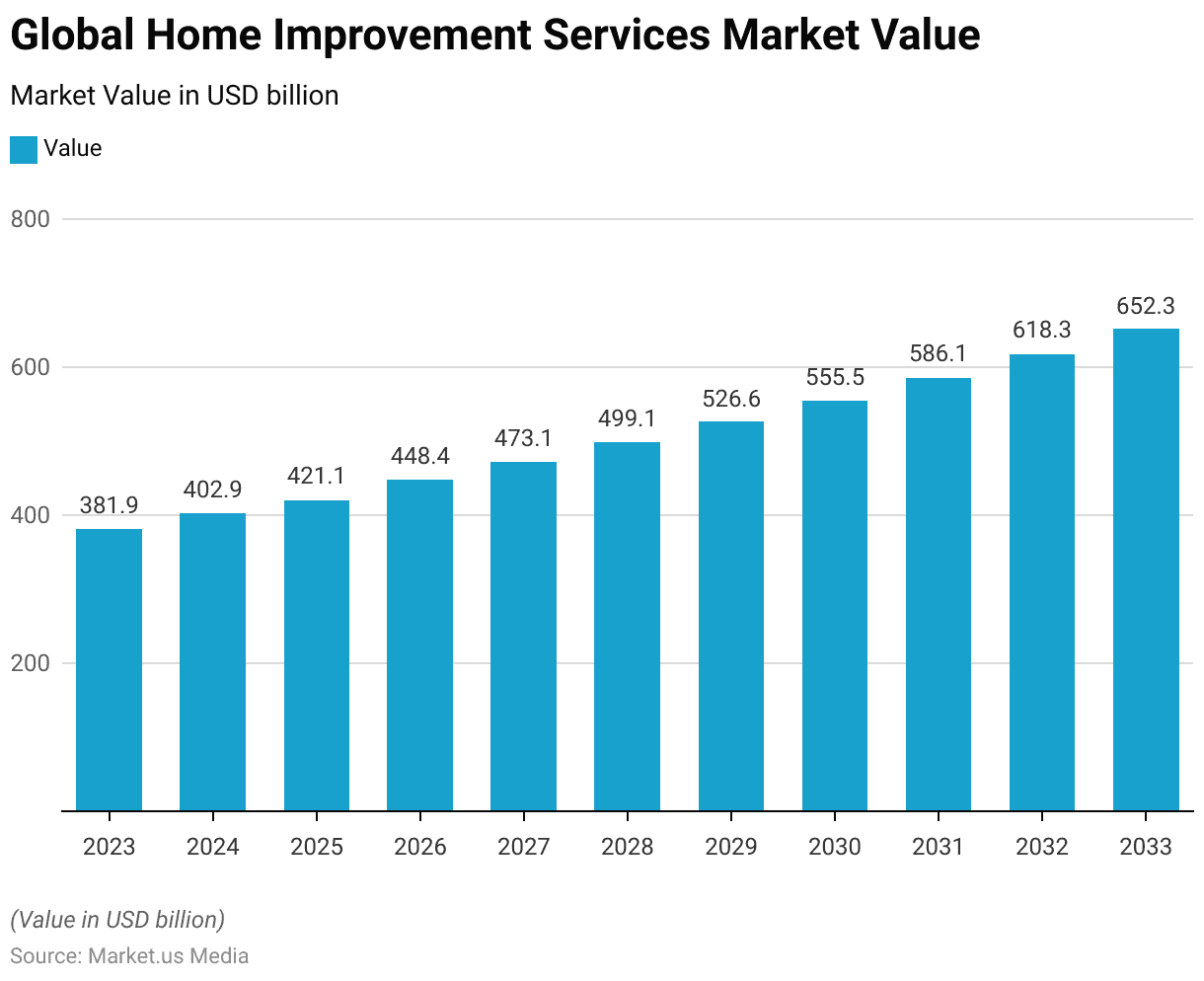
Global Home Improvement Services Industry Size – By Deployment Statistics
2023-2027
- The global home improvement services market is projected to experience notable growth from 2023 to 2027, with distinct contributions from both offline and online channels.
- In 2023, the total market value is expected to be USD 381.9 billion. With offline sales accounting for USD 229.1 billion and online sales for USD 152.8 billion.
- This upward trend continues in 2024, with the market anticipated to reach USD 402.9 billion, where offline sales will contribute USD 241.7 billion and online sales USD 161.2 billion.
- By 2025, the market is projected to grow to USD 421.1 billion. With offline sales at USD 252.7 billion and online sales at USD 168.4 billion.
- The growth trajectory remains strong in 2026, with the market expected to reach USD 448.4 billion, divided into USD 269.0 billion from offline sales and USD 179.4 billion from online sales.
- In 2027, the market value is projected to be USD 473.1 billion. With offline sales contributing USD 283.9 billion and online sales USD 189.2 billion.
2028-2033
- The positive trend continues into 2028, with the market value expected to reach USD 499.1 billion, split between USD 299.5 billion from offline sales and USD 199.6 billion from online sales.
- By 2029, the market is projected to grow to USD 526.6 billion. With offline sales at USD 316.0 billion and online sales at USD 210.6 billion.
- In 2030, the total market value is anticipated to be USD 555.5 billion. With offline sales accounting for USD 333.3 billion and online sales for USD 222.2 billion.
- Further growth is expected in 2031, with the market reaching USD 586.1 billion. Divided into USD 351.7 billion from offline sales and USD 234.4 billion from online sales.
- By 2032, the market value is projected to be USD 618.3 billion, with offline sales at USD 371.0 billion and online sales at USD 247.3 billion.
- Finally, in 2033, the market is expected to reach USD 652.3 billion. With offline sales contributing USD 391.4 billion and online sales USD 260.9 billion.
- This data highlights the robust and continuous expansion of the global home improvement services market. With significant growth in both offline and online channels over the next decade.
(Source: market.us)

Global Home Decor Industry Statistics
Global Home Decor Industry Size Statistics
- The global home decor market is projected to experience substantial growth from 2023 to 2033.
- In 2023, the market value is expected to be USD 672.7 billion.
- This growth trend continues in 2024, with the market anticipated to reach USD 696.4 billion and further to USD 718.2 billion in 2025.
- By 2026, the market is projected to rise to USD 750.9 billion and continue to USD 781.4 billion in 2027.
- The upward trajectory is sustained in 2028, with the market value expected to be USD 805.9 billion, and in 2029, it is projected to grow to USD 823.8 billion.
- The market is anticipated to reach USD 853.4 billion in 2030, reflecting robust and continuous expansion.
- By 2031, the market is expected to achieve a value of USD 880.2 billion and further to USD 911.9 billion in 2032.
- Finally, in 2033, the global home decor market is projected to reach USD 949.0 billion.
- This data underscores the consistent and significant growth anticipated in the home decor market over the next decade.
(Source: market.us)
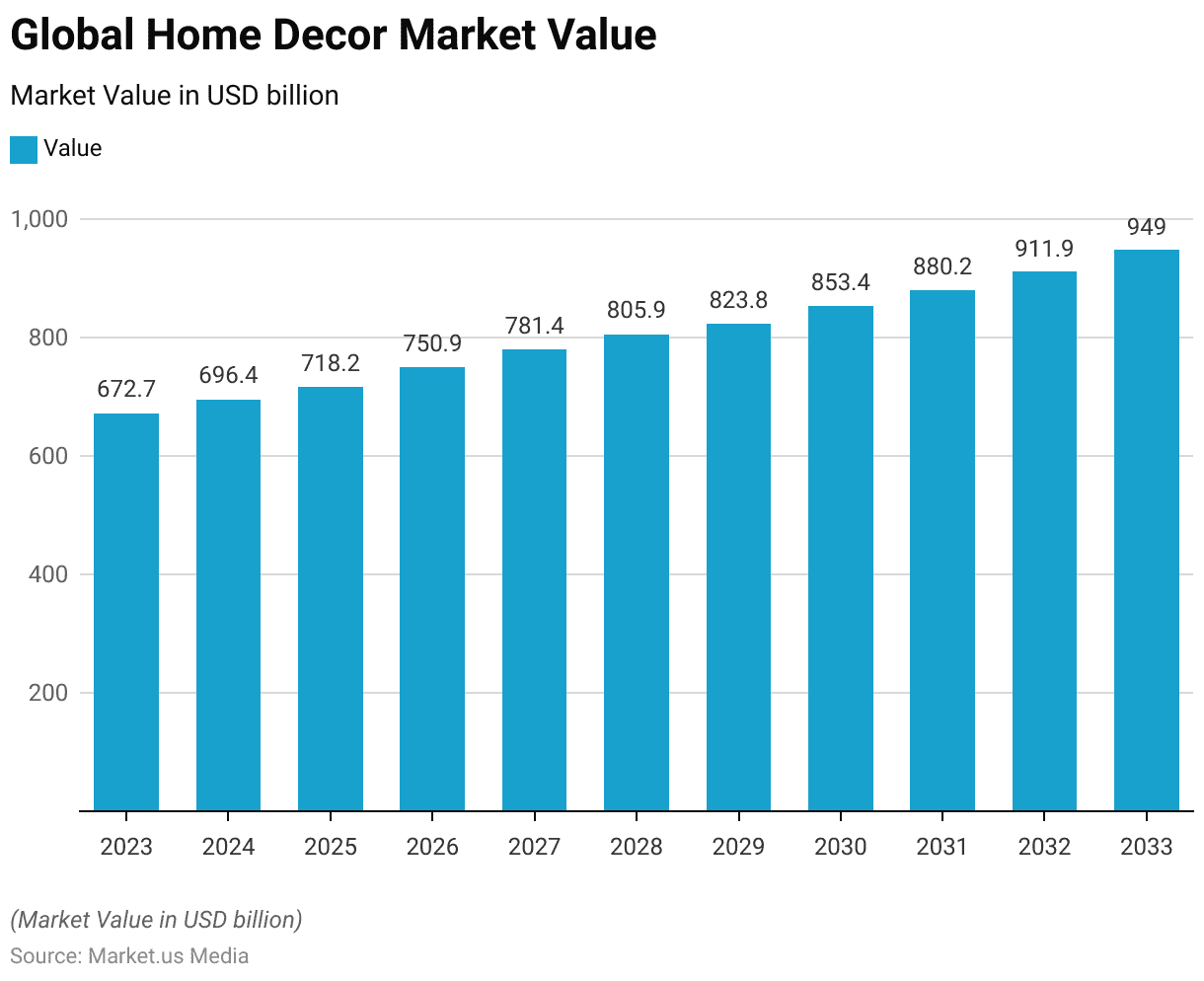
Smart Homes Statistics
Global Smart Home Industry Size Statistics
- The global smart home market has shown remarkable growth from 2018 to 2028, reflecting increasing consumer adoption and technological advancements.
- In 2018, the market value stood at USD 52.9 billion.
- This value increased significantly in 2019 to USD 66.9 billion and continued its upward trajectory in 2020, reaching USD 78.0 billion.
- The year 2021 marked a substantial jump, with the market value soaring to USD 103.4 billion.
- In 2022, the market further expanded to USD 114.5 billion, and by 2023, it is expected to reach USD 134.8 billion.
- The positive growth trend is projected to continue, with the market anticipated to grow to USD 154.4 billion in 2024 and USD 174.0 billion in 2025.
- By 2026, the market value is expected to rise to USD 193.6 billion, followed by USD 212.5 billion in 2027.
- The expansion is set to persist through 2028, with the global smart home market projected to achieve a value of USD 231.6 billion.
- This data highlights the rapid and continuous growth of the smart home market, driven by advancements in smart technologies and increasing consumer demand for connected home solutions.
(Source: Statista)
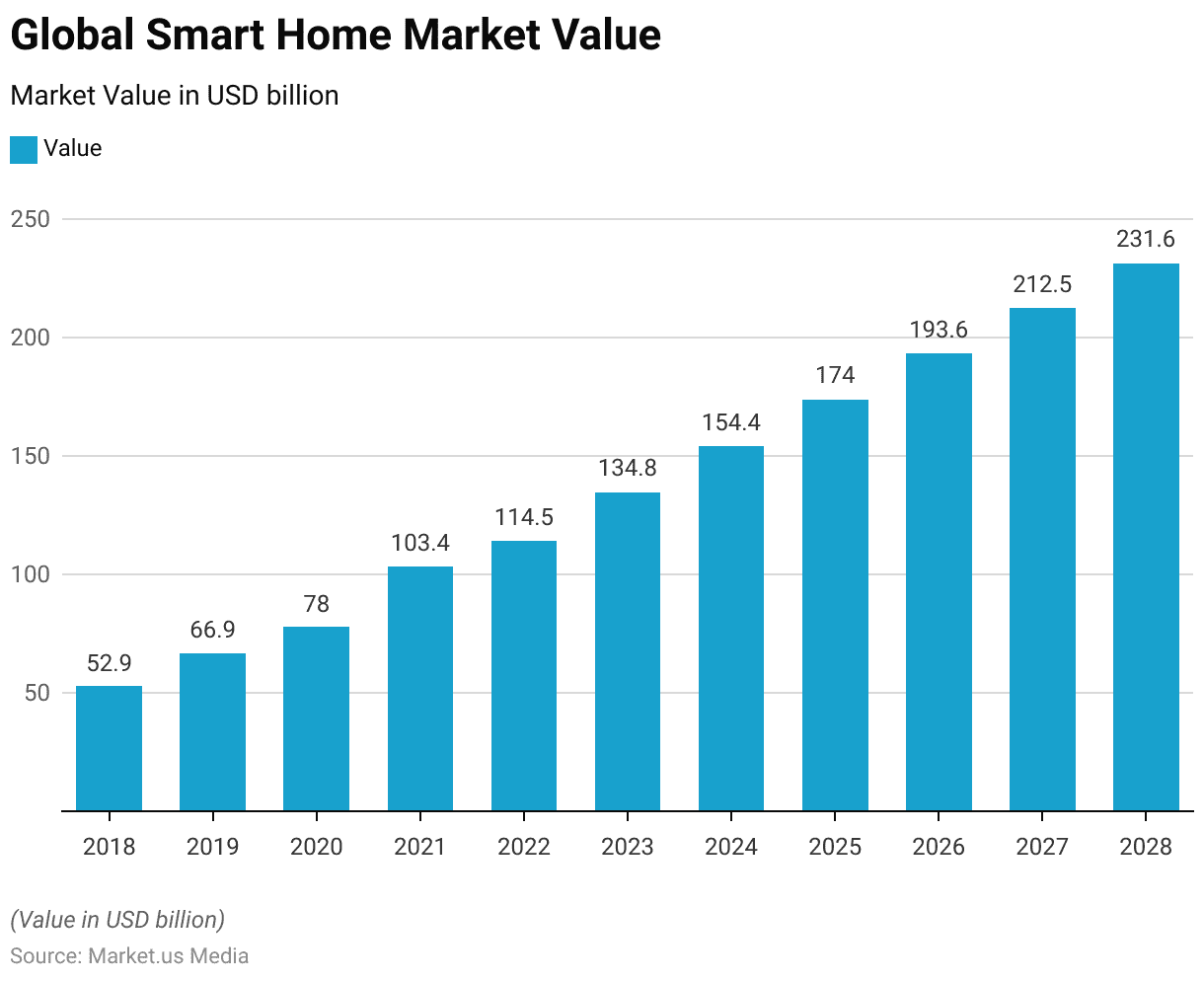
Competitive Landscape of the Global Smart Home Market
- The smart home market is characterized by a diverse range of brands, each holding varying shares of the market.
- Leading the market are Irobot, LG, and Samsung, each with a 5% share.
- Ring, TP-LINK, and Xiaomi each capture a 3% share of the market, reflecting their strong presence in the industry.
- Amazon, Bosch, Google, and Switch Bot each hold a 2% market share. Showcasing their significant but slightly lesser influence compared to the leading brands.
- The remaining 68% of the market is comprised of various other brands. Indicating a highly fragmented market with numerous players contributing to the overall landscape.
- This distribution highlights the competitive nature of the smart home market. With a multitude of brands vying for consumer attention and market share.
(Source: Statista)
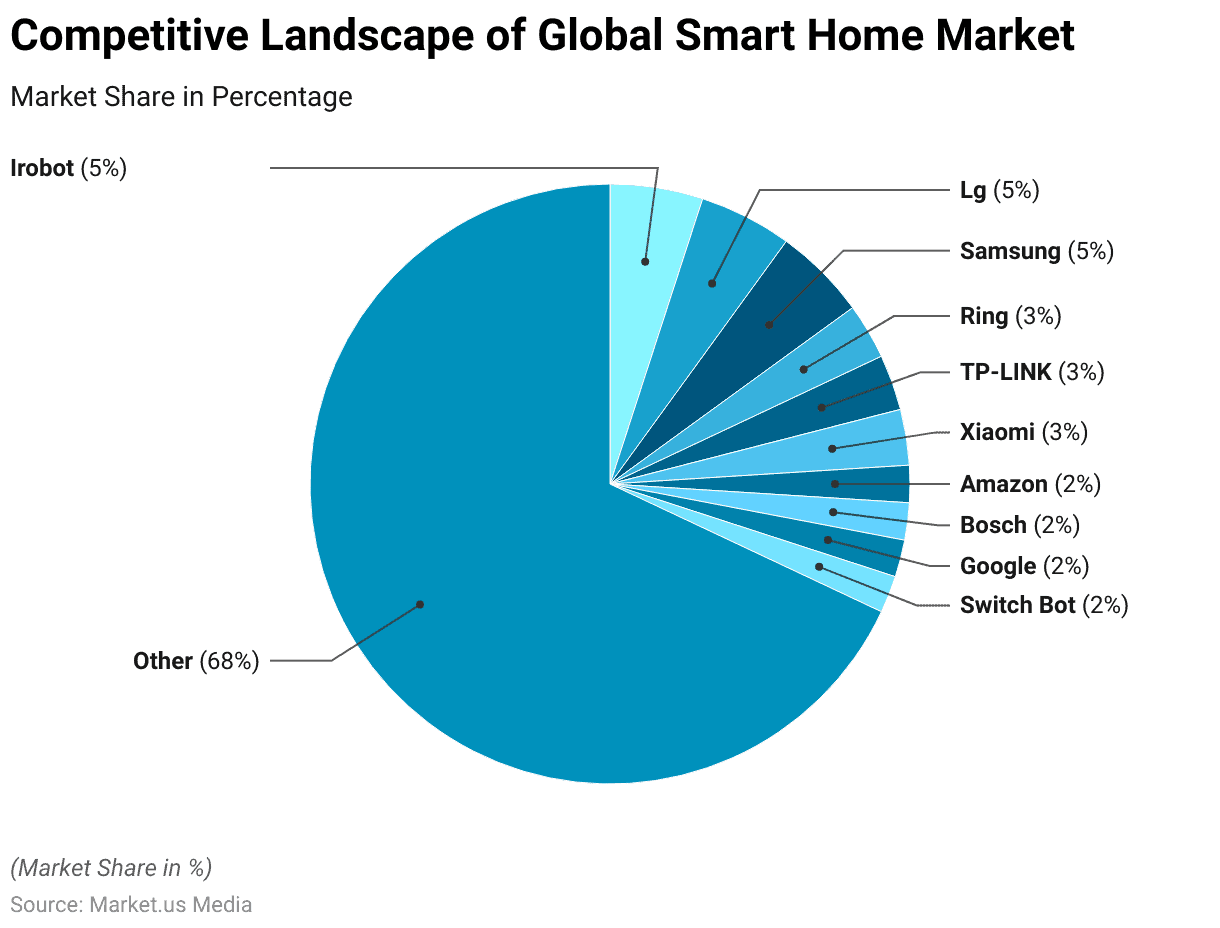
Global Smart Home Market Revenue – By Country
- The smart home market revenue across various countries showcases significant regional disparities and highlights key markets driving the industry’s growth.
- The United States leads with a substantial market revenue of USD 38,800 million, followed closely by China, which generates USD 32,370 million.
- The United Kingdom ranks third with USD 10,970 million. While Japan follows with USD 9,450 million and Germany with USD 8,710 million.
- South Korea and India also represent significant markets, with revenues of USD 7,205 million and USD 6,486 million, respectively.
- Australia contributes USD 3,710 million to the market, with France close behind at USD 3,472 million.
- Canada generates USD 3,142 million in revenue, followed by Russia at USD 2,073 million and Brazil at USD 1,846 million.
- Mexico’s smart home market revenue stands at USD 1,779 million. While Sweden and Italy contribute USD 1,414 million and USD 1,340 million, respectively.
- This data underscores the global reach and varied market sizes within the smart home industry. With significant contributions from both developed and emerging economies.
(Source: Statista)

Number of Users of Smart Homes Worldwide
- The number of households adopting smart home technologies worldwide has been increasing significantly from 2019 to 2028.
- In 2019, there were 191.38 million smart home users, which grew to 224.18 million in 2020.
- This upward trend continued in 2021 with 262.71 million users, and in 2022, the number reached 307.82 million.
- The growth accelerated further in 2023, with 360.68 million households using smart home technologies.
- Projections for the coming years indicate a continued rapid increase in adoption. By 2024, the number of smart home users is expected to rise to 422.19 million, and in 2025, it is anticipated to reach 493.55 million.
- The trend is projected to persist, with 576.22 million users by 2026 and 672.50 million by 2027.
- By 2028, the number of smart home users worldwide is expected to reach an impressive 785.16 million.
- This data underscores the growing popularity and widespread adoption of smart home technologies across the globe.
(Source: Statista)

Home Care Brands Statistics
- In 2022, the leading home care brands worldwide were measured by household reach, represented in millions of Consumer Reach Points.
- Vim emerged as the most widely reached brand, with 1,876 million Consumer Reach Points.
- Downy followed with 1,343 million, and Sunlight was close behind with 1,337 million.
- Tide and Comfort were also prominent, reaching 811 million and 728 million households, respectively.
- Ariel achieved 673 million Consumer Reach Points, while Surf garnered 581 million.
- Omo reached 493 million households, and Clorox followed with 430 million. Harpic and Glade had notable reaches of 395 million and 309 million, respectively.
- Lysol, Febreze, and Fairy were significant players as well, with household reaches of 296 million, 272 million, and 260 million, respectively.
- Suavitel and Bounty each reached around 244-245 million households. Scott was close behind with 238 million.
- Vape and Scotch Brite both reached 223 million and 214 million households, respectively.
- Finally, Air Wick also achieved 214 million Consumer Reach Points.
- This data highlights the extensive consumer reach and influence of these leading home care brands in 2022.
(Source: Statista)

Home Care Services and Solutions and Services Statistics
Most Popular Smart Home Services and Solutions
- In 2015, a survey conducted in the United Kingdom revealed the varying levels of appeal that consumers found in different smart services and solutions.
- Security and control services emerged as the most appealing. With 38% of respondents indicating a preference for these solutions.
- Entertainment and connectivity, along with energy and lighting services. Both appealed to 36% of respondents, reflecting significant interest in these areas as well.
- Health-related smart services attracted 29% of the respondents. While smart appliances were found appealing by 28% of those surveyed.
- This data highlights the diverse interests of U.K. consumers in the realm of smart home technologies during that period.
(Source: Statista)
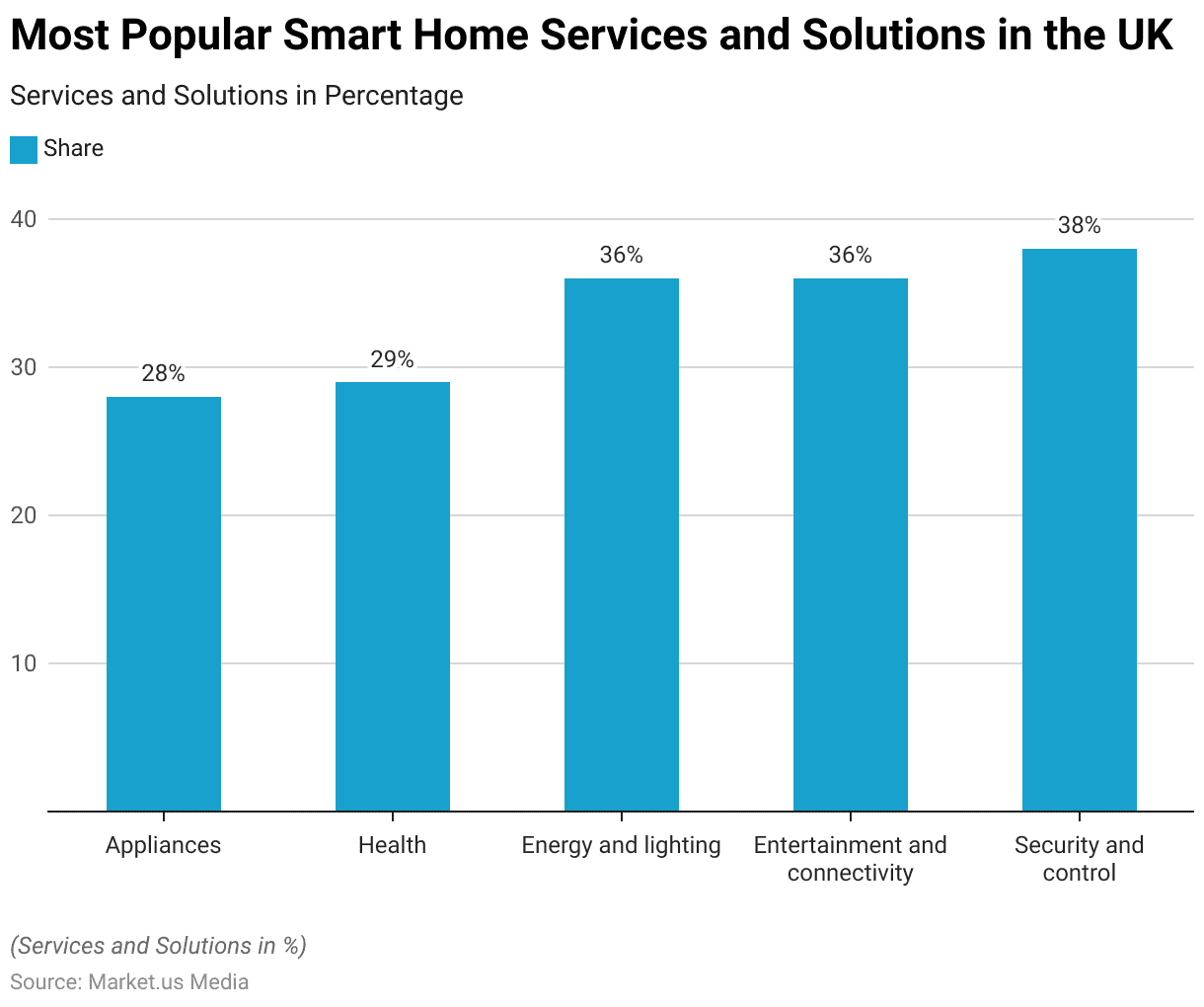
Smart Home Products and Services
- The global adoption of smart home products and services has shown significant growth from 2017 to 2027.
- In 2017, 186 million households were utilizing smart home technologies.
- This number increased to 219 million in 2018 and further to 254 million in 2019.
- The upward trend continued in 2020 with 276 million households, and by 2021, the number rose to 306 million.
- A substantial increase was observed in 2022, with 394 million households adopting smart home products and services.
- However, a slight decline occurred in 2023, bringing the number to 359 million.
- Projections indicate a rebound and continued growth, with the number of households expected to reach 381 million in 2024, 402 million in 2025, and significantly rising to 533 million by 2027.
- This data underscores the growing popularity and widespread integration of smart home technologies worldwide over the decade.
(Source: Statista)

Leading Home Improvement Services Requested
- As of March 2018, the distribution of home improvement services requested in Italy reveals a diverse range of needs among consumers, as reflected by suppliers’ quotes.
- The installation of air conditioning systems was the most frequently requested service, accounting for 21% of the suppliers’ quotes.
- Painting services followed closely, representing 19% of the requests.
- The installation or substitution of heating systems constituted 15% of the quotes while moving services accounted for 10%.
- Energetic certification and house renovation services each garnered 7% of the quotes.
- Similarly, the installation of mosquito nets also made up 7% of the requests.
- Window installation services were quoted in 5% of the cases. Matching the percentage for the maintenance or inspection of heating systems.
- Lastly, cleaning system services represented 4% of the suppliers’ quotes.
- This data highlights the varied demands in the Italian home improvement market, with a significant emphasis on installations and energy-related services.
(Source: Statista)
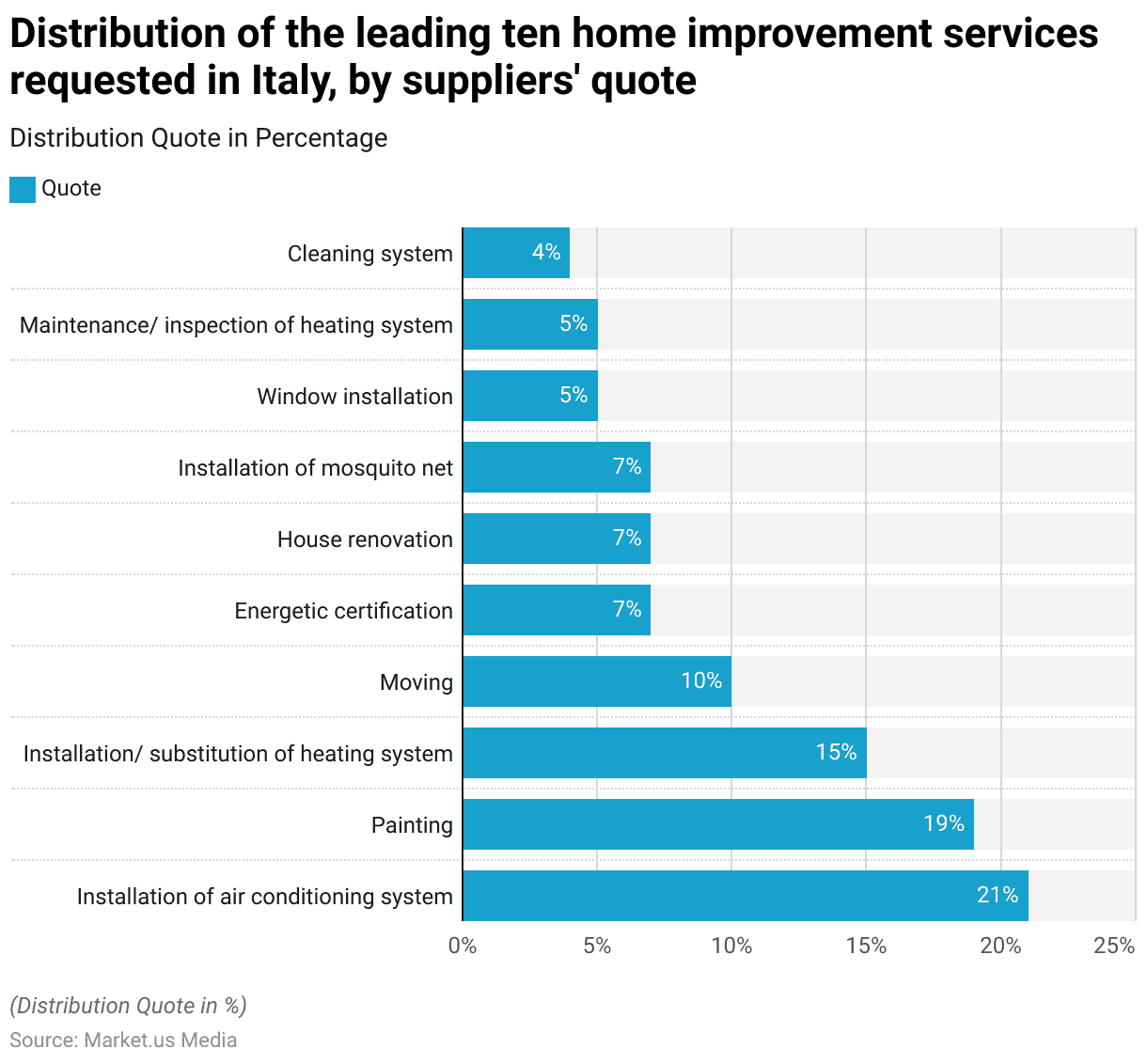
Demographic Distribution of Home Care Workers
Home Care Industry Statistics By Age
- In 2021, the distribution of home care workers in the United States varied significantly across different age groups.
- Workers aged 16 to 24 years constituted 10% of the home care workforce.
- The age group of 25 to 34 years represented 15% of the workers.
- Individuals aged 35 to 44 years made up 18% of the home care workforce.
- The 45 to 54 years age group accounted for 22% of the workers, while those aged 55 to 64 years comprised the largest share at 23%.
- Finally, home care workers aged 65 years and older represented 12% of the workforce.
- This data highlights the broad age range of individuals employed in the home care sector, with a notable concentration of workers in the 45 to 64 years age bracket.
(Source: Statista)
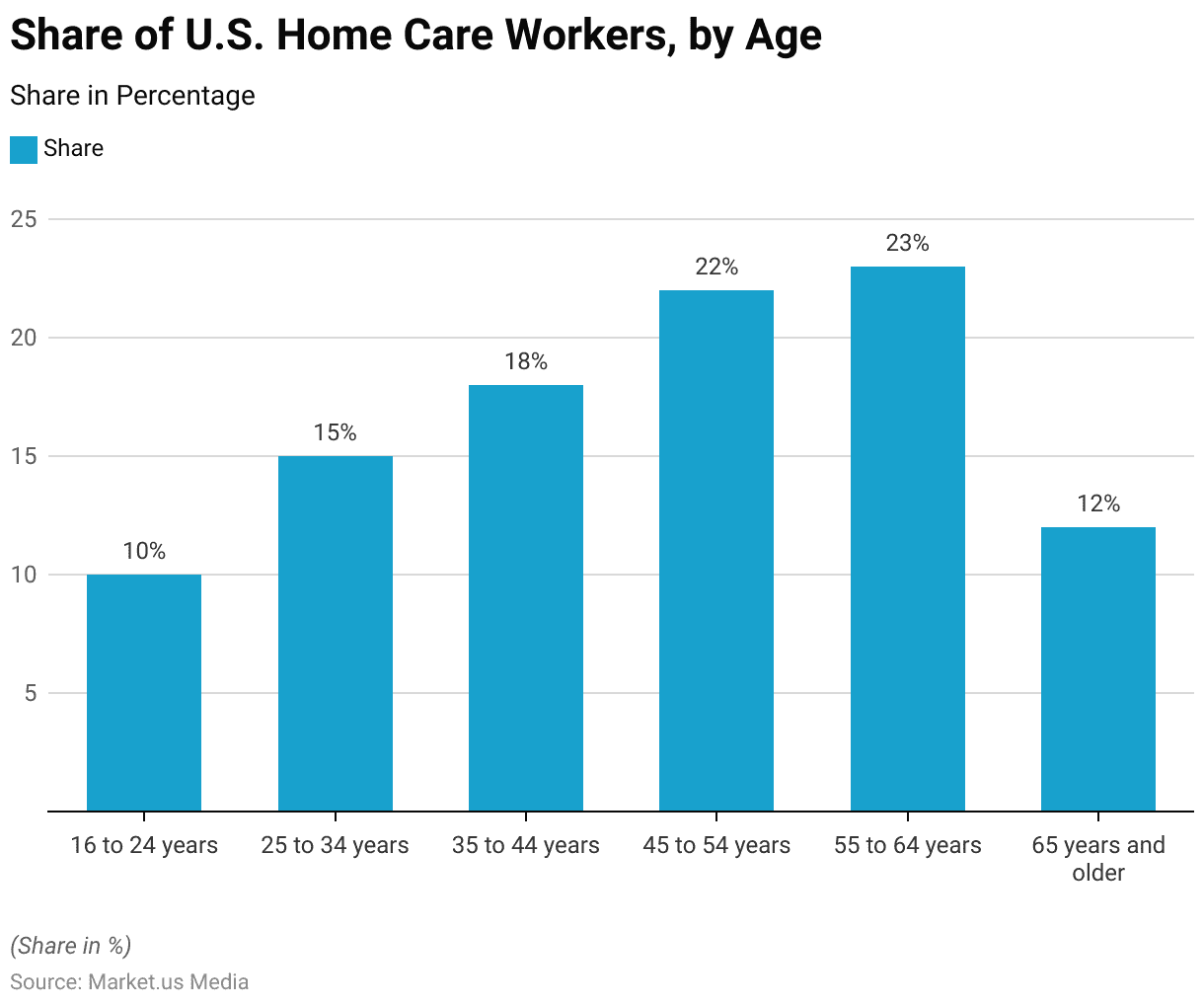
Home Care Industry Statistics By Gender
- In 2021, the home care workforce in the United States was predominantly female.
- Women constituted 85% of home care workers, highlighting the significant gender disparity in this sector.
- In contrast, men made up only 15% of the workforce.
- This data underscores the predominance of female workers in the home care industry, reflecting broader trends in caregiving and related professions.
(Source: Statista)
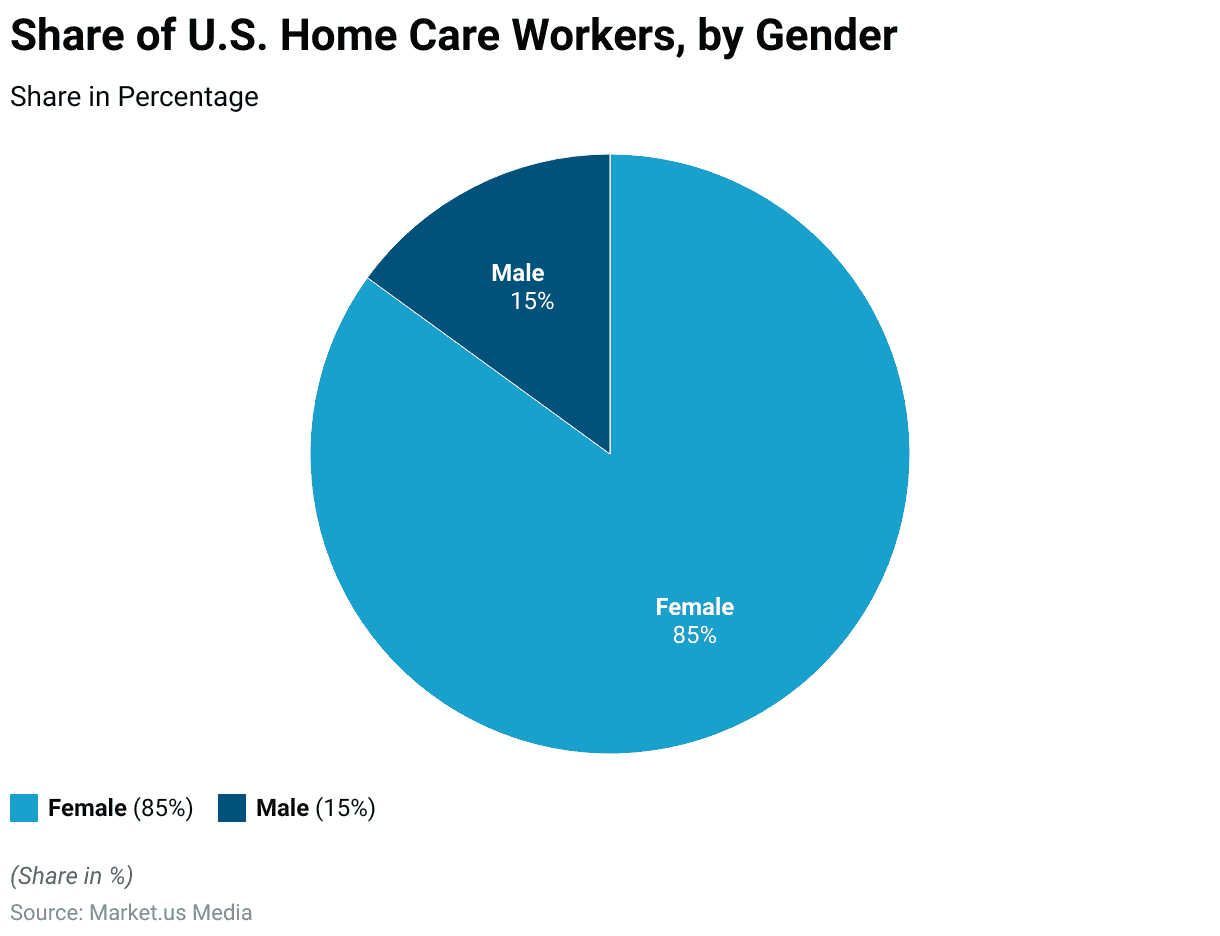
Home Care Industry Statistics By Race and Ethnicity
- In 2021, the racial and ethnic distribution of home care workers in the United States showcased a diverse workforce.
- White, non-Hispanic, or Latino individuals constituted 34% of the home care workforce.
- Black or African American workers represented 26%, and Hispanic or Latino workers also made up 26% of the total.
- Asian or Pacific Islander individuals accounted for 9% of home care workers, while those categorized as “Other” comprised 5%.
- This data highlights the varied racial and ethnic composition of the home care sector, reflecting the broad demographic landscape of those employed in this field.
(Source: Statista)

Home Care Industry Statistics By Education Level
- In 2021, the educational background of home care workers in the United States varied widely.
- A significant portion of the workforce, 36%, were high school graduates.
- Those with some college education but no degree made up 24% of the workers.
- Home care workers with an associate’s degree or higher constituted 21% of the workforce.
- Meanwhile, 19% of home care workers had less than a high school education.
- This distribution reflects the diverse educational levels among individuals employed in the home care sector.
(Source: Statista)
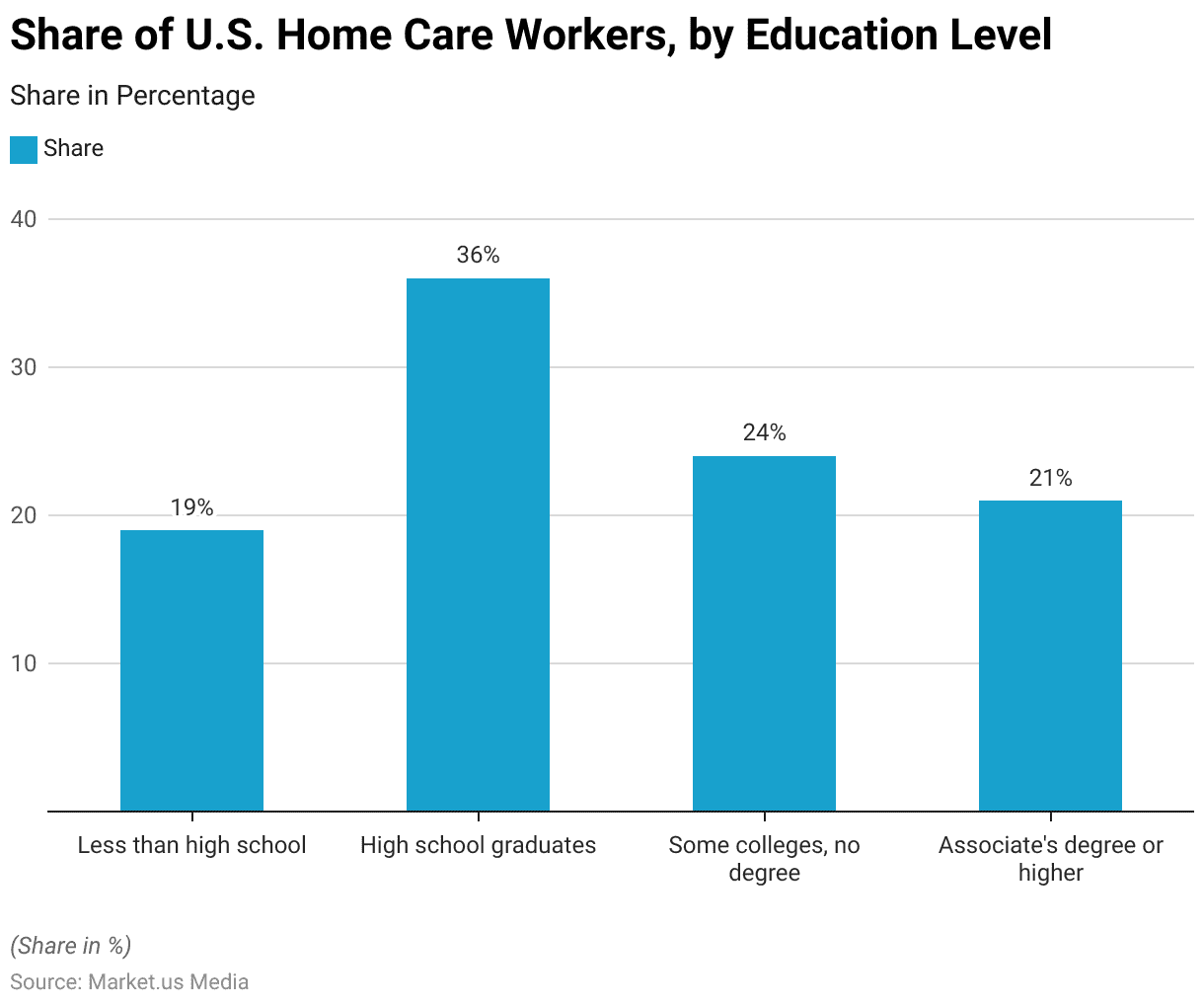
Home Care Industry Statistics By Employment Status
- In 2021, the employment status of home care workers in the United States revealed a diverse range of work arrangements.
- A majority of the workforce, 56%, were employed full-time.
- Part-time workers constituted a significant portion, with 36% working part-time for non-economic reasons.
- Additionally, 7% of home care workers were employed part-time due to economic reasons.
- This data highlights the various employment statuses within the home care sector, indicating a mix of full-time and part-time employment among workers.
(Source: Statista)
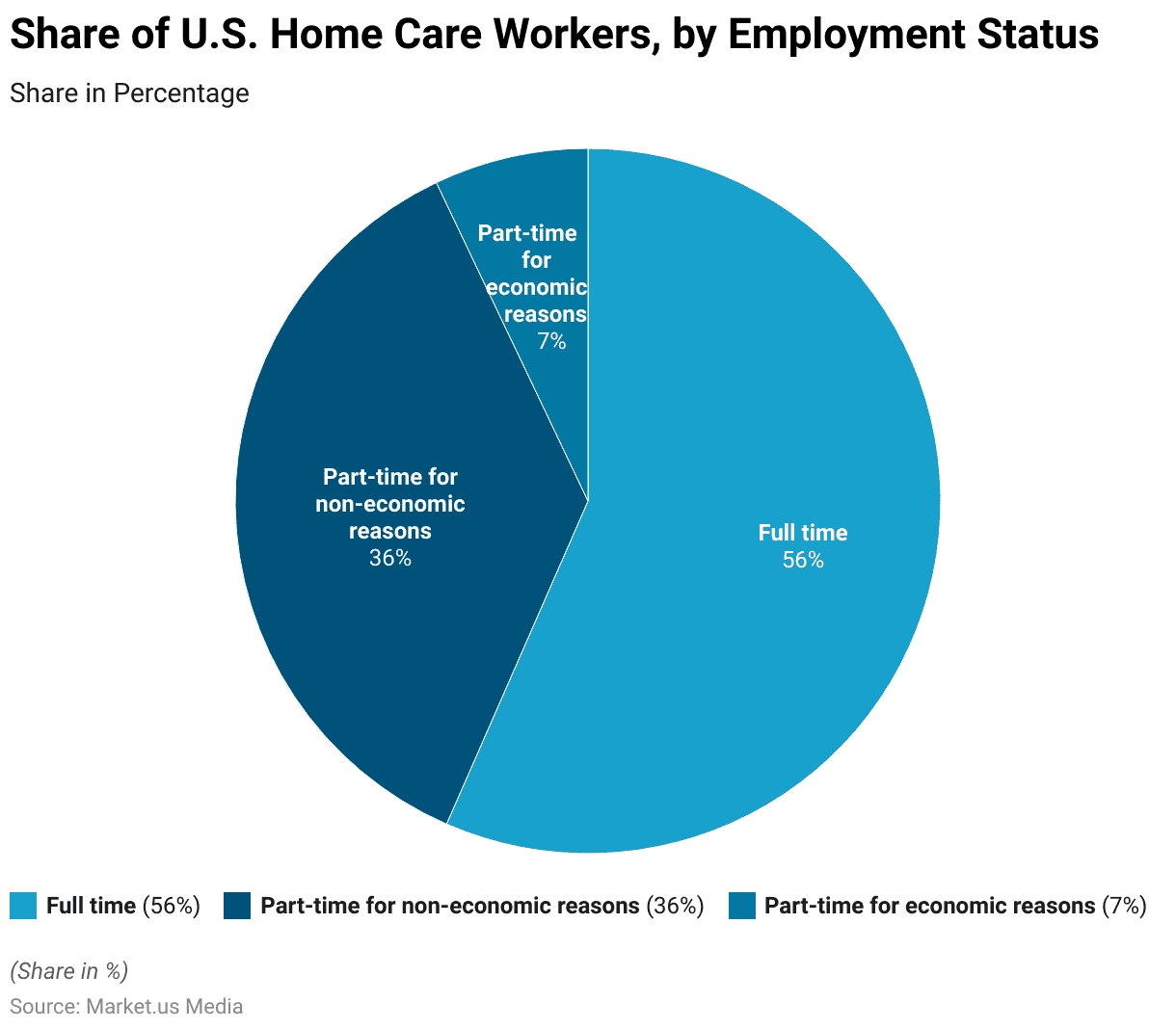
Home Care Industry Spending Statistics
Home Health Spending
2013-2016
- From 2013 to 2026, spending on home health in the United States has shown a steady increase across various payers.
- In 2013, private health insurance expenditures were USD 6.3 billion, while out-of-pocket spending was USD 6.4 billion. Other payers contributed USD 2.4 billion, with Medicare spending USD 34.4 billion and Medicaid USD 29.1 billion. Other public health insurance accounted for USD 1.1 billion.
- By 2014, private health insurance spending rose to USD 8.3 billion, and out-of-pocket expenses increased to USD 7.4 billion. Other payers spent USD 2.7 billion, Medicare USD 34.7 billion, and Medicaid USD 29.6 billion, with other public health insurance decreasing to USD 0.5 billion.
- In 2015, private health insurance reached USD 9.4 billion, out-of-pocket spending USD 8.8 billion, other payers USD 2.7 billion, Medicare USD 35.1 billion, Medicaid USD 32 billion, and other public health insurance USD 0.7 billion.
- The upward trend continued in 2016, with private health insurance at USD 9.6 billion, out-of-pocket at USD 8.1 billion, other payers at USD 2.6 billion, Medicare at USD 37.4 billion, Medicaid at USD 34 billion, and other public health insurance at USD 0.7 billion.
2017-2021
- In 2017, these figures further increased to USD 10.8 billion for private health insurance, USD 9 billion for out-of-pocket, USD 2.7 billion for other payers, USD 38.8 billion for Medicare, USD 35 billion for Medicaid, and USD 0.7 billion for other public health insurance.
- By 2018, private health insurance spending was USD 12.2 billion, out-of-pocket USD 10.2 billion, other payers USD 2.8 billion, Medicare USD 40.3 billion, Medicaid USD 35.9 billion, and other public health insurance USD 0.8 billion.
- In 2019, private health insurance surged to USD 16.6 billion, out-of-pocket USD 12.5 billion, other payers USD 3.3 billion, Medicare USD 44 billion, Medicaid USD 36.6 billion, and other public health insurance USD 0.9 billion.
- The year 2020 saw a slight decrease in private health insurance to USD 15.7 billion, out-of-pocket spending at USD 12.6 billion, a significant increase in other payers to USD 13 billion, Medicare spending at USD 41.6 billion, Medicaid at USD 40.2 billion, and other public health insurance at USD 0.6 billion.
- By 2021, private health insurance spending slightly increased to USD 15.9 billion, out-of-pocket to USD 12.9 billion, and other payers decreased to USD 6.2 billion, Medicare rose to USD 46.6 billion, Medicaid to USD 42.8 billion, and other public health insurance remained at USD 0.8 billion.
- This data highlights the growing financial commitment to home health care across multiple payer sources in the United States over the past decade.
(Source: Statista)
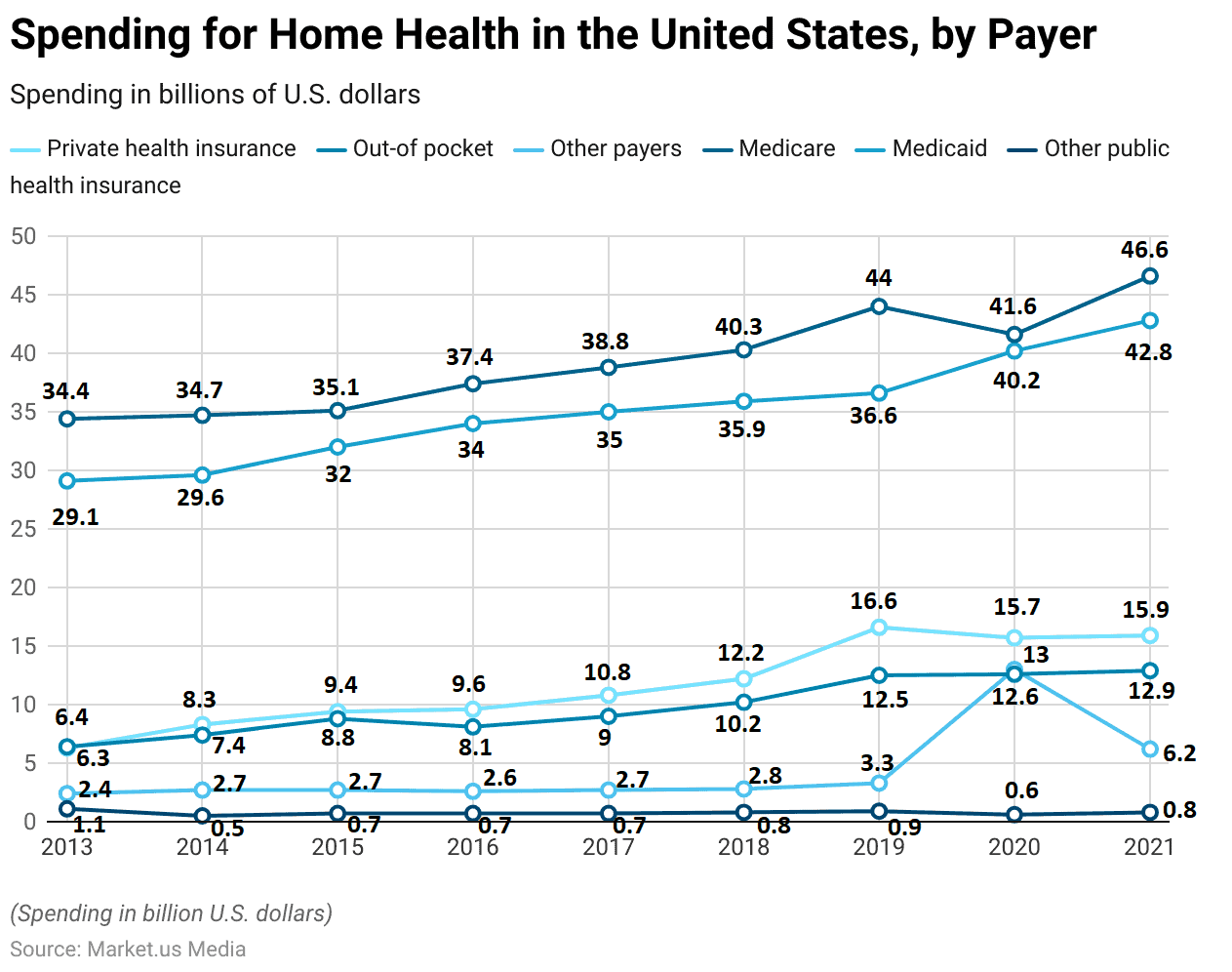
Industry Revenue of Home Health Care Services Statistics
- The home healthcare services industry in California has experienced significant revenue growth from 2012 to 2024.
- In 2012, the industry’s revenue was USD 5,169.12 million, which increased to USD 5,575.91 million in 2013.
- The upward trend continued in 2014, with revenues reaching USD 6,012.03 million. In 2015, the industry saw further growth, reaching USD 6,477.49 million.
- By 2016, the revenue had climbed to USD 6,972.28 million, and then to USD 7,496.42 million in 2017.
- In 2018, the industry’s revenue rose to USD 7,822.06 million, and in 2019, it continued to grow to USD 8,133.60 million.
- However, there was a slight dip in 2020, with revenue decreasing to USD 7,777.40 million.
- This decline was short-lived, as the revenue rebounded in 2021 to USD 8,147.64 million.
- The growth persisted in 2022, with revenues reaching USD 8,593.85 million.
- The upward trajectory is expected to continue, with projections for 2023 indicating revenues of USD 9,123.49 million, and for 2024. The industry’s revenue is anticipated to reach USD 9,317.91 million.
- This data underscores the robust expansion and increasing financial importance of the home healthcare services industry in California over the past decade and into the future.
(Source: Statista)

Home Health Care Expenditure Industry Statistics
- Home healthcare expenditure in the United States has seen a dramatic increase from 1960 to 2022, reflecting the growing demand and investment in home health services.
- In 1960, the expenditure was a modest USD 0.1 billion. This amount doubled by 1970, reaching USD 0.2 billion.
- The expenditure saw a substantial jump by 1990, escalating to USD 12.5 billion, and continued to rise significantly into the new millennium, with USD 32.3 billion spent in 2000.
- The upward trend persisted, with home healthcare expenditure reaching USD 49.3 billion in 2005 and further increasing to USD 70.5 billion by 2010.
- The following years saw consistent growth: USD 74.6 billion in 2011, USD 78.1 billion in 2012, and USD 81 billion in 2013.
- By 2014, the expenditure had risen to USD 84.7 billion, followed by USD 89.6 billion in 2015 and USD 93.8 billion in 2016.
- In 2017, home healthcare spending reached USD 99.4 billion and surpassed the USD 100 billion mark
- in 2018, with expenditures totaling USD 105.6 billion. The growth continued into 2019, with spending at USD 112.4 billion.
- The year 2020 saw a significant increase to USD 125.1 billion, slightly rising to USD 125.4 billion in 2021.
- By 2022, home healthcare expenditure had grown to USD 132.9 billion.
- This data highlights the substantial and continuous investment in home healthcare services over the past six decades in the United States.
(Source: Statista)
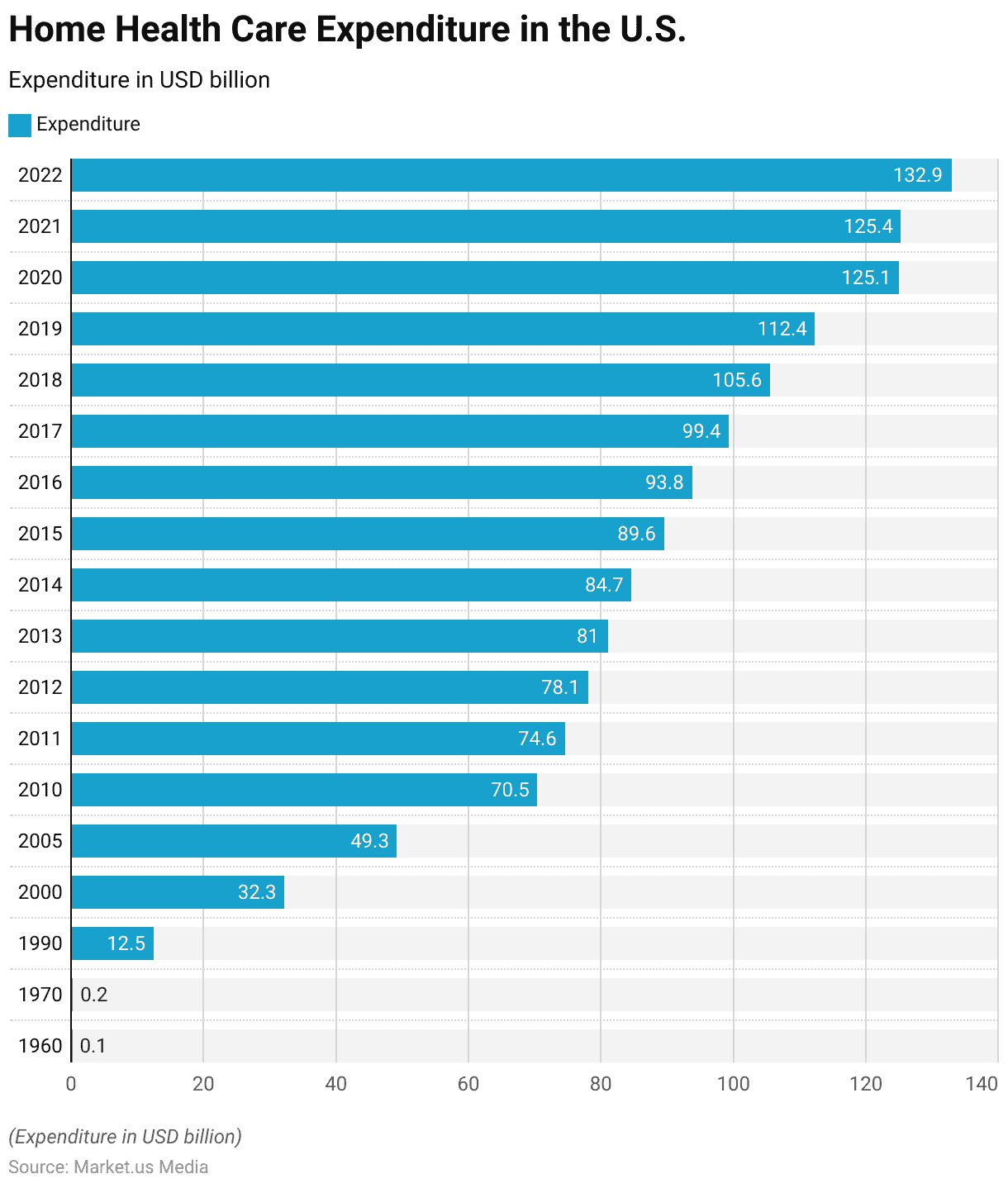
Challenges and Concerns
Smart Home Devices Adoption Concerns
- In 2017, various concerns influenced the adoption of smart home devices worldwide, as reflected by the share of respondents expressing different levels of concern.
- High prices were a significant worry, with 44% of respondents being very concerned, 33% somewhat concerned, 17% slightly concerned, and 5% not at all concerned.
- Hacking and cybersecurity were even more alarming, with 48% very concerned, 26% somewhat concerned, 18% slightly concerned, and 8% not at all concerned.
- Reliability issues also posed a considerable concern, with 38% very concerned, 32% somewhat concerned, 20% slightly concerned, and 11% not at all concerned.
- Compatibility problems were noted by 30% of respondents as very concerned. 38% somewhat concerned, 21% slightly concerned, and 12% not at all concerned.
- Concerns about technology becoming outdated affected 24% of respondents very concerned, 37% somewhat concerned, 26% slightly concerned, and 13% not at all concerned.
- Lastly, the difficulty in managing smart home devices was a concern for 20% of respondents who were very concerned, 34% somewhat concerned, 26% slightly concerned, and 20% not at all concerned.
- This data highlights the diverse and significant concerns consumers had regarding smart home technology adoption.
(Source: Statista)

Consumers’ Health and Safety Concerns with Home Care Cleaning Products Industry Statistics
- In 2019, U.S. consumers expressed significant health and safety concerns regarding home cleaning products.
- The primary concern was the safety of the ingredients, with 41% of respondents indicating they were very concerned about this issue.
- Accuracy of product claims was also a notable worry, with 29% of respondents expressing high levels of concern.
- Additionally, 25% of consumers were very concerned about products containing ingredients they were unfamiliar with.
- Eco-friendly and green attributes of cleaning products were a major concern for 23% of respondents.
- Finally, 20% of consumers were very concerned about the origin of the products, indicating a strong interest in knowing where these products came from.
- This data underscores the importance of transparency and safety in the home cleaning products market for U.S. consumers.
(Source: Statista)
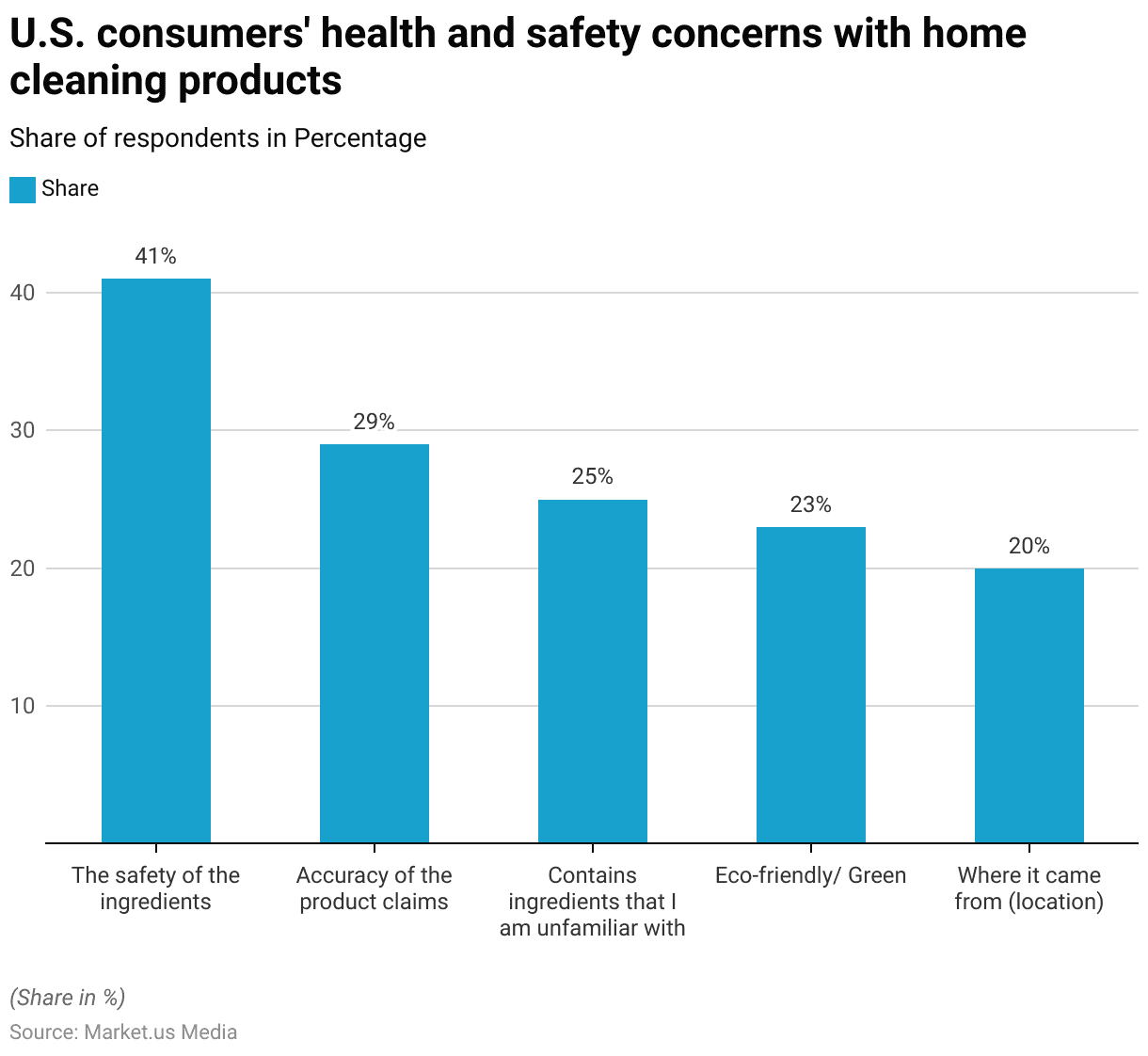
Regulations, Legislations, and Laws for the Home Care Industry Statistics
- The home care industry is governed by a complex array of regulations, legislations, and laws that vary significantly by country, shaping the operational landscape for providers.
- Further, in the United States, the Department of Labor‘s new rule on classifying workers has made it imperative for agencies to correctly distinguish between employees and independent contractors using a detailed “Economic Realities Test” to avoid misclassification penalties.
- However, the Centers for Medicare and Medicaid Services (CMS) has introduced updates in the Home Health Final Rule for 2024, including payment adjustments and new coverage guidelines, which impact reimbursement rates and care standards.
- The Federal Trade Commission is considering a ban on non-compete clauses, which could significantly alter employment practices within the industry.
- In the U.K., home care regulations are overseen by the Care Quality Commission (CQC), focusing on standards for safety and quality of care.
- Similarly, in Canada, provincial regulations such as those by the Ontario Ministry of Health enforce standards for home care services.
- Moreover, these regulations, among others globally, ensure that agencies operate within frameworks that protect both workers and patients. Demanding rigorous compliance and continuous adaptation to new legal requirements.
(Sources: Axis Care, Axxess, Home Health Care News (HHCN), Home Care Association of America, SimiTree)
Recent Developments
Acquisitions and Mergers:
- LHC Group acquires Almost Family: In early 2023, LHC Group was a leading provider of home health services. They completed its acquisition of Almost Family for $2.4 billion. This merger aims to expand LHC Group’s footprint across the U.S. and enhance its service offerings in home health, hospice, and personal care.
- Amedisys acquires Compassionate Care Hospice: Amedisys is a major player in the home healthcare sector. It acquired Compassionate Care Hospice for $340 million in mid-2023. This acquisition is expected to strengthen Amedisys’s presence in the hospice care market and broaden its continuum of care services.
New Product Launches:
- Philips introduces HomeSafe with AutoAlert: In early 2024, Philips launched HomeSafe with AutoAlert, an advanced medical alert system designed for seniors. This product includes fall detection technology and 24/7 access to emergency help. Aimed at increasing safety and independence for older adults living at home.
- Honor’s Home Care Platform: Honor, a home care technology company, introduced a new integrated home care platform in mid-2023. This platform connects caregivers, clients, and families, providing real-time updates and personalized care plans to enhance the home care experience.
Funding:
- Papa secures $150 million: In 2023, Papa, a company that connects older adults with companionship and assistance, raised $150 million in a Series D funding round. The funds will be used to expand their service offerings and reach more clients across the U.S.
- CareAcademy raises $50 million: CareAcademy, an online training platform for home care workers, secured $50 million in early 2024 to develop new courses. Improve its technology, and scale its platform to meet the growing demand for skilled caregivers.
Technological Advancements:
- AI in Home Care: Advances in AI are being integrated into home care services to improve patient monitoring. Personalized care plans, and predict health issues before they become serious. This technology is helping to enhance the quality of care and reduce hospital readmissions.
- Telehealth Integration: The integration of telehealth services in-home care is growing, allowing patients to consult with healthcare professionals remotely. Reducing the need for in-person visits, and making healthcare more accessible and convenient.
Market Dynamics:
- Growth in Home Care Market: The global home care market is projected to grow at a CAGR of 7.8% from 2023 to 2028, driven by an aging population. The rising prevalence of chronic diseases, and a preference for aging in place.
- Increased Demand for Personal Care Services: There is a significant increase in demand for personal care services, including assistance with daily activities. Due to the growing number of elderly individuals who require support but wish to remain in their homes.
Conclusion
Home Care Industry Statistics – The home care industry has seen substantial growth driven by demographic shifts, technological advancements, and evolving consumer preferences.
Moreover, significant revenue increases, such as California’s home health care services rising from USD 5.17 billion in 2012 to an anticipated USD 9.32 billion by 2024. With the expansion of smart home products reaching 785.16 million households worldwide by 2028, the sector is flourishing.
Despite this, consumers express concerns about high prices, cybersecurity, and product reliability. The workforce is predominantly female and diverse in age and education.
Leading brands like Vim and Downy have extensive reach. Health and safety concerns, particularly regarding product ingredients, remain significant.
Addressing these concerns and ensuring transparency and affordability will be key to sustaining industry growth.
FAQs
The home care industry encompasses a range of services provided in a client’s home to assist with daily living activities and medical needs. This includes personal care, companionship, homemaking, and healthcare services such as nursing and therapy.
The growth is driven by demographic shifts such as an aging population, and advancements in home care technologies. Increasing consumer demand for convenience, and a rising focus on health and wellness.
Consumers are primarily concerned about high prices, cybersecurity, reliability, compatibility, and the potential for technology to become outdated. In 2017, 48% of respondents were very concerned about hacking and cybersecurity.
The workforce is predominantly female (85% in 2021) and includes a wide range of ages, with the largest share being between 55 and 64 years old. Educational backgrounds vary, with 36% being high school graduates and 24% having some college education.
Leading brands include Vim, Downy, and Sunlight, with Vim reaching 1,876 million Consumer Reach Points in 2022. Other notable brands are Tide, Comfort, and Ariel.
Discuss your needs with our analyst
Please share your requirements with more details so our analyst can check if they can solve your problem(s)



